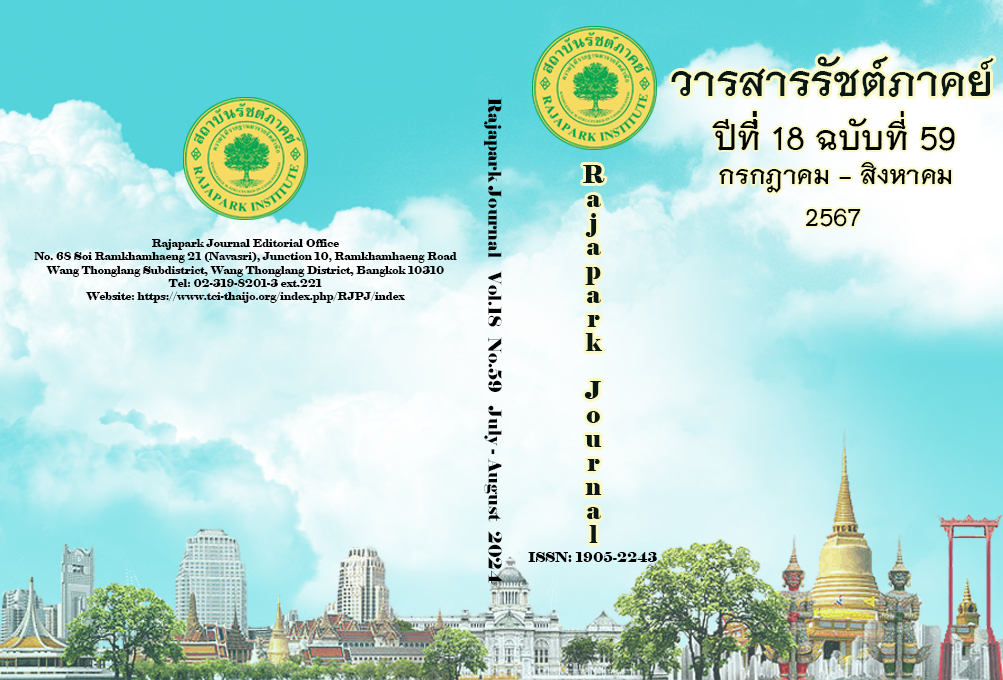Study of Application of Geo-Information Technology to Spatial Survey and Assessment of Creative Tourism Potential in Baan Noi Rim Khlong Community
Main Article Content
Abstract
This research aims to achieve four objectives: first, to utilize geo-information technology for spatial exploration and data mapping in the Baan Noi Rim Khlong community of Sa Kaeo province; second, to evaluate the potential of these tourism resources; third, to assess the feasibility of developing creative tourism resources; and fourth, to analyze the network by considering the conditions of distance and travel time to arrange suitable tourism routes. The researcher collected data from the three sample groups: 1) stakeholders, agencies, and local government organizations; 2) community members involved in tourism management; and 3) tourists. A qualitative analysis was performed to identify current situational problems and obstacles, SWOT analysis, and potential in various areas; thirdly, to assess the feasibility of developing creative tourism resources by categorizing and evaluating four resource groups: cultural heritage, way of life, arts, and products catering to various demands by the group of experts; and finally, to analyze the network by considering the conditions of distance and travel time to arrange suitable tourism routes. The research findings reveal: 1) Tourism Resource Potential: The area's natural resources support tourism and interactive activities with local villagers; 2) Tourist Potential: Tourists seeking community-based experiences are highly satisfied. Needed improvements include better public transport, local transportation, and diverse tourism programs. The tourist demand is focused on diverse and small-group activities, along with greater engagement with the community. 3) Market and Business Potential: social media and influencer promotion have boosted tourist interest in homestays, but limited availability remains a challenge. The community product business lacks online sales channels. In addition, the overall readiness of tourism resources was found to be high, with an average score of 4.04, indicating a high possibility for the development of sustainable creative tourism destinations. Subsequently, network analysis using Dijkstra’s algorithm was conducted to optimize tourism routes. The findings of this research can serve as guidelines for spatial management and developmental planning, fostering outstanding creative tourism destinations and sustainable income generation for local communities.
Article Details

This work is licensed under a Creative Commons Attribution-NonCommercial-NoDerivatives 4.0 International License.
Views and opinions appearing in the Journal it is the responsibility of the author of the article, and does not constitute the view and responsibility of the editorial team.
References
Arikul, P. (2017). Handbook of geographic information systems, remote sensing techniques, and GPS surveying for use in smart farm management planning according to the Thailand 4.0 policy. National Research Council of Thailand (NRCT).
Arpamongkolrat, N., & Poolsawat, P. (2017). Travel planning system in Samutprakarn with Dijkstra’s algorithm. In Paper presented at the 5th Academic Science and Technology Conference, (1476-1483).
Aunphoklang, W. (2012). Sugarcane transportation management Using network and multi-objective Decision analyses[Master’s thesis, Suranaree University of Technology].
Aunphoklang, W., & Sangphong, O. (2023). Training document: Network analysis with geographic information system data management software. New Graduate Project.
Department of Tourism, Ministry of Tourism & Sports. (2017). Creative Tourism Management Handbook. https://www.dot.go.th/news/internal-audit-plan/detail/3052/8
GISTDA: Geo-Informatics and Space Technology Development Agency (Public Organization). (2009). Handbook of space technology and geo-informatics. Amarin.
Hunwisai, D. (2022). Dijkstra’s algorithm for solving the fuzzy shortest path problem on networks under trapezoidal fuzzy number. UTK Research Journal, 16(1), 30-41. https://ph02.tci-thaijo.org/index.php/rmutk/article/view/246441
Iamchuen, N., Anucharn, T., & Jussapalo, C. (2022). Enhancement of secondary-city tourism in Phatthalung province towards value creation using augmented reality technology. BUSCIJ, 27(1), 101-119. https://scijournal.buu.ac.th/index.php/sci/article/view/3988
Iamviriyawat, P. (2018). Strategy development for community elevation to creative tourism of Banphunamron Danchang district, Suphanburi province Thailand[Doctoral Dissertation, Silpakorn University].
Khopolklang, N., & Kaewsanga, K. (2017). Local development guidelines for promoting creative tourism in Chiang Khan district, Loei province(Research report). Suranaree University of Technology.
Kitwinit, S., Kaewfai, J., Hama, S., Dayi, D., Waranantakul, W., Poomkaew, S., & Maro, K. (2019). A study of creative tourism resources in the tourism community of Lidon sub-district, Mueang district, Yala province(Research Report). Yala Rajabhat University.
Langkulkasattrin, W., & Akasuwan, N. (2018). Applied of geographic information system to support by community tourism: Case study of Kohyor, Songkhla. In Paper presented at the 1st National Conference on Humanities and Social Sciences, Songkhla Rajabhat University, Thailand, (521-530).
Meepong, T. (2022). Community enterprise entrepreneurs in Baan Noi Rim Khlong homestay farm. Personal communication, April 9, 2022.
Ministry of Tourism and Sports. (2022). Domestic tourist statistics within the country Q1-Q4 2022 (Eastern region).
https://www.mots.go.th/news/category/766
Phuthong, P., Jaroenjit, J., & Zhou, N. (2016). Geographic information system for natural attraction in Klong Sok Sub-district, Phanom district, Surat Thani province. In Paper presented at the 7th Hatyai National and International Conference, Hatyai University, Thailand. (1437-1448).
Richards, G., & Raymond, C. (2000). Creative tourism. ATLAS News, 23, 16-20. https://www.academia.edu/1785786/Creative_Tourism_Richards_and_Raymond_2000
Suwanvijit, W. (2018). Create tourism activities for elderly tourists in the basin community of Khlong Pa Payom-Khlong Ta Nae, Phatthalung province. Area Based Development Research Journal, 10(6), 514-528. https://so01.tci-thaijo.org/index.php/abcjournal /article/view/156256
Thai Tourism. (2013). Creative tourism. In Pleerux, N., Anuruksakornkul, P., & Pongsangiam, T. (2016). Creative tourism in the Eastern Areas(Research report), Burapha University.
Verbyla, L.D. (2002). Practical GIS analysis. Taylor & Francis.
Witheetrairong, Y. (2019). Fundamental knowledge of geographic information systems. Department of Geography, Faculty of Arts, Silpakorn University.


